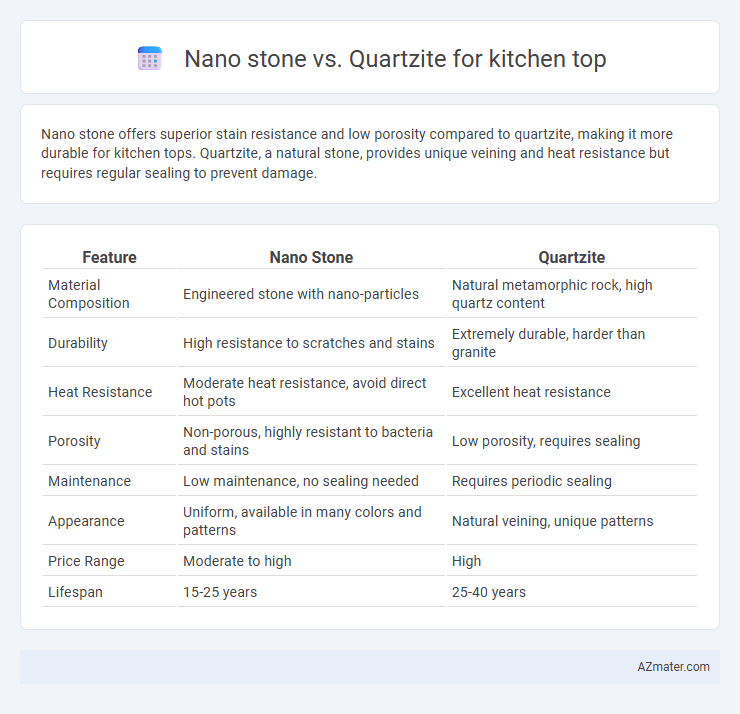Nano stone offers superior stain resistance and low porosity compared to quartzite, making it more durable for kitchen tops. Quartzite, a natural stone, provides unique veining and heat resistance but requires regular sealing to prevent damage.
Table of Comparison
| Feature | Nano Stone | Quartzite |
|---|---|---|
| Material Composition | Engineered stone with nano-particles | Natural metamorphic rock, high quartz content |
| Durability | High resistance to scratches and stains | Extremely durable, harder than granite |
| Heat Resistance | Moderate heat resistance, avoid direct hot pots | Excellent heat resistance |
| Porosity | Non-porous, highly resistant to bacteria and stains | Low porosity, requires sealing |
| Maintenance | Low maintenance, no sealing needed | Requires periodic sealing |
| Appearance | Uniform, available in many colors and patterns | Natural veining, unique patterns |
| Price Range | Moderate to high | High |
| Lifespan | 15-25 years | 25-40 years |
Introduction to Nano Stone and Quartzite
Nano stone is an engineered surface composed of natural quartz and resin, offering superior durability, scratch resistance, and non-porous properties ideal for kitchen countertops. Quartzite is a natural metamorphic rock formed from sandstone, prized for its hardness, heat resistance, and unique, natural veining that enhances kitchen aesthetics. Both materials provide excellent longevity, but nano stone's engineered consistency contrasts with quartzite's natural variations, influencing maintenance and design preferences.
Composition and Material Properties
Nano stone is composed of a blend of natural minerals, resins, and pigments, resulting in a non-porous, highly durable surface resistant to scratches and stains. Quartzite is a natural metamorphic rock primarily made of quartz, known for its hardness and heat resistance, but it can be more porous and may require sealing to prevent staining. Both materials offer distinct advantages in kitchen tops, with nano stone providing superior uniformity and maintenance ease, while quartzite delivers natural stone aesthetics and exceptional toughness.
Aesthetic Differences and Color Options
Nano stone offers a sleek, uniform appearance with a polished finish, ideal for modern kitchen designs seeking a minimalist look. Quartzite displays natural veining and a varied color palette, including whites, grays, and earthy tones, providing a more organic and luxurious aesthetic. Color options in nano stone are typically consistent and engineered, while quartzite's natural formation results in unique patterns and subtle color variations.
Durability and Scratch Resistance
Nano stone offers exceptional durability and high scratch resistance due to its engineered composition of natural stone and resin, making it ideal for heavy kitchen use. Quartzite, a natural stone, exhibits remarkable hardness and scratch resistance but can require periodic sealing to maintain its resilience against stains and surface damage. Both materials stand out for durability, though nano stone provides a lower-maintenance surface with superior resistance to wear and scratches.
Maintenance and Cleaning Requirements
Nano stone kitchen tops require low maintenance due to their non-porous surface, resisting stains and bacteria efficiently with just regular wiping using mild detergent. Quartzite, while highly durable and heat-resistant, demands sealing upon installation and periodic resealing to prevent stains and moisture penetration, along with gentle cleaning using pH-neutral cleaners. Both materials offer strong hygiene performance, but nano stone's minimal upkeep makes it more suitable for busy kitchens prioritizing ease of cleaning.
Heat and Stain Resistance
Nano stone offers superior heat resistance, withstanding temperatures up to 500degF without damage, making it ideal for kitchen tops exposed to hot pots and pans. Quartzite is also highly heat resistant but may suffer minor damage at extreme temperatures, typically above 700degF, and is less stain-resistant due to its natural porous structure. Nano stone's non-porous surface provides enhanced stain resistance against common kitchen spills like wine, oil, and acids, whereas quartzite requires regular sealing to maintain its stain resistance.
Cost Comparison and Value for Money
Nano stone countertops generally offer a lower upfront cost compared to quartzite, making them a budget-friendly option for kitchen surfaces. Quartzite, while more expensive, provides superior durability and a unique natural stone aesthetic that enhances long-term value and resale appeal. Considering maintenance, nano stone's stain and scratch resistance can reduce repair costs, but quartzite's heat resistance and robustness contribute to greater longevity and investment worth over time.
Installation Process and Challenges
Nano stone installation for kitchen tops requires precision cutting and adhesive application due to its engineered composition, offering flexibility in shaping but necessitating professional handling to avoid damage. Quartzite, being a natural stone, involves a more labor-intensive process with heavy slabs requiring specialized tools and experienced installers to manage its brittleness and weight during cutting and fitting. Challenges for nano stone include ensuring seamless joins and avoiding surface scratches, while quartzite installation demands careful handling to prevent cracks and addressing uneven slab thickness for a perfect countertop fit.
Environmental Impact and Sustainability
Nano stone countertops are engineered with resin and natural minerals, offering a lower environmental footprint due to reduced quarrying and longer durability, which minimizes waste over time. Quartzite, a natural metamorphic stone, requires extensive mining that can disrupt ecosystems and generate more carbon emissions, though it remains durable and recyclable. Choosing nano stone supports sustainability through eco-friendly manufacturing processes, while quartzite's impact depends on responsible sourcing and extraction practices.
Choosing the Right Material for Your Kitchen Top
Nano stone offers exceptional durability and resistance to scratches and stains, making it ideal for heavy-use kitchen tops. Quartzite, a natural stone, provides a unique aesthetic with heat resistance and excellent hardness, but requires periodic sealing to prevent etching. Choosing the right material depends on balancing maintenance preferences, budget, and desired visual appeal for a long-lasting kitchen surface.

Infographic: Nano stone vs Quartzite for Kitchen Top
 azmater.com
azmater.com